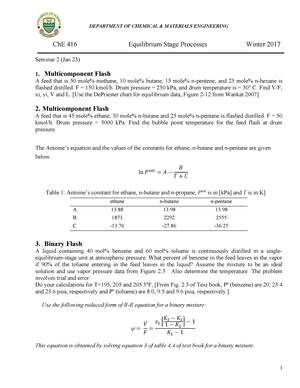
Trial-and-error method Given the composition of a superheated vapor and PTOTAL, find Tdp and (xi)dp VLE: mole balance: Algorithm: Pick a temperature T and find the corresponding Ki(T) values for each component Calculate the xi value for each Ki(T) Check to see if Sxi = 1 If not, pick a new temperature and repeat Lecture 3 ends hereġ4 Relative volatility volatility relative volatility Initial guess: (weighted average of boiling points of pure components) Next guess: pick a reference component (A) find Tnext using DePriester Chartġ3 Dew point calculation for multi-component mixtures
DEPRIESTER CHART HIGH TEMPERATURES HOW TO
Trial-and-error method Given the composition of a subcooled liquid and PTOTAL, find Tbp and (yi)bp VLE: mole balance: Algorithm: Pick a temperature T and find the corresponding Ki(T) values for each component Calculate the yi value for each Ki(T) Check to see if Syi = 1 If not, pick a new temperature, repeat How to pick a temperature? How to pick the next temperature? Raoult’s Law ideal liquid: non-ideal liquid: activity coefficient Dalton’s Law ideal gas: non-ideal gas: fugacity coefficientġ1 Bubble point calculation for multi-component mixtures Wankat (ISBN: ) Copyright © 2012 Pearson Education, Inc. Prog.,85, April 1978 copyright 1978, AIChE reproduced by permission of the American Institute of Chemical Engineers) volatility At 2000 kPa, what is the boiling point of ethane? At 15 ☌, what is the saturated vapor pressure of isobutane? At 0 ☌ and 500 kPa, what is the volatility of n-hexane? At 2000 kPa, what is the boiling point of ethane? -6 ☌ At 15 ☌, what is the saturated vapor pressure of isobutane? 250 kPa At 0 ☌ and 500 kPa, what is the volatility of n-hexane? 0.006 From Separation Process Engineering, Third Edition by Phillip C. Iįigure Modified DePriester chart (in S.I.

All rights reserved.ĥ Useful definitions Boiling/bubble point Tbp: temperature at which the average liquid molecule has just enough kinetic energy to escape from the surface of the liquid into the gas phase Recall that kinetic energy follows a Boltzmann distribution, so molecules with higher than average kinetic energy can still escape from the surface at T 1 Consider a pure compound: What is the boiling range of this mixture? Figure 2-3 Temperature-composition diagram for ethanol-water From Separation Process Engineering, Third Edition by Phillip C. What is its dew point? What is the composition of the first drop? boiling range bubble point 圎,initial yE,initial 3. Consider a superheated binary vapor that is 40 mol% ethanol. What is its bubble point? What is the composition of the first bubble? dew point 2. Consider a sub-cooled binary liquid that is 40 mol% ethanol. Pure liquids have a boiling point mixtures have a boiling range, delimited by their bubble point and dew point.


yA superheated vapor subcooled liquid 2-phase region saturated vapor line saturated liquid line TA xA How big should the drum be? What height should the nozzle be? What T and P should the drum be? What T and P should the feed be?Ĭonsider a binary (i.e., 2-component) system with 2-phases: What do we know? yA + yB = 1 xA + xB = 1 yA ≠ xA Tvap, Pvap yA, yB Tliq, Pliq xA, xB At equilibrium: Tvap = Tliq Pvap = Pliq Gibbs’ Phase Rule: degrees of freedom = # components (C) - # phases (P) + 2 For a binary, 2-phase system: 2 – = 2 We can specify only 2 intensive variables (all others are fixed, by VLE)ģ Specify P and T 2 graphs in one: T vs.


 0 kommentar(er)
0 kommentar(er)
